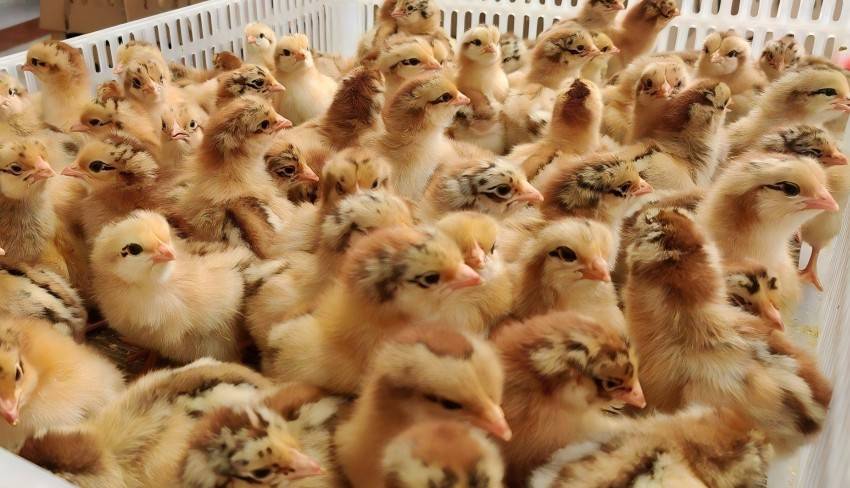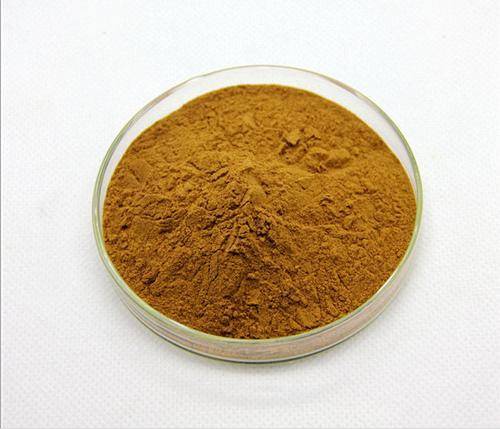rosmarinus officinalisエキスはどのように動物の餌に使用されますか?
ローズマリーand ローズマリーエキスs have been attracting attention for a long time in China and abroad because of their antioxidant, antibacterial, antitumor, anti-inflammatory, hypolipidemic and hepatoprotective functions. This paper summarizes the absorption and metabolism of rosemary extracts, their biological functions and their applications in animal production, and aims to provide theoretical basis for further promoting the application of rosemary extracts in animal production.
ローズマリー(rosmarinus oficinalis l .)は、多年生の芳香植物、低木で、最大2 mの高さの葉の枝と独特の香りを放つ緑色の葉を持っています。中国の主な生産地域は貴州省、湖南省、雲南省、広西チワン族自治区などの南部です。ローズマリーの生物学的影響の主な原因となる化合物はポリフェノールであり、その極性に応じてフェノール酸とフェノールジテルペンに分けることができる。最も豊富なフェノール酸はロスマリン酸であり、フェノールジテルペンの中にはラムネチン酸とラムノールがある。sclareolic酸の内容sclareolとrosemarinic酸のローズマリー木の叶が458.63、1,554.78と3,154.36μg / g、[1]。
また、他の追跡コンポーネントの存在(メチル仙人ローズマリーフェノールさまの下でローズマリーdialdehyde、epi-isorhizophenol、epi-rosemaryフェノール、とフラボノイドを多く)などの精油の成分(1、8、- camphorolα-pinene、または「つらら)多くの生物活动と関係があると見られている[2]。ローズマリーは、料理の香辛料、食品産業における天然防腐剤、観賞用および薬用植物として広く使用されています。ローズマリーの活性成分は、その抗酸化、抗菌、抗腫瘍、抗炎症、血中脂質、肝臓保護、および免疫調節特性のためにホットな研究課題となっている。本論文では、生体内でのローズマリー抽出物の吸収と代謝、生物学的機能、動物生産への応用について以下のようにまとめ、今後のローズマリー抽出物の動物生産への応用研究の参考とする。
1生体内でのローズマリー抽出物の吸収と代謝
Rosmarinic acid has been identified as one of the main components of rosemary extract, and several studies have shown that it is metabolized by intestinal microorganisms to caffeic acid and its derivatives prior to absorption, but the microorganisms and enzymes involved in this biotransformation are not clear [3-4]. Liu Shengnan et al. [5] showed that the pattern of total phenol content in the digested products of rosemary ethanol extract was as follows: an increasing trend in the simulated gastric digestion stage, probably because the bound polyphenols present in the rosemary ethanol extract were released under acidic conditions, which led to an increase in the total phenol content [6]; and a decreasing trend in the simulated intestinal digestion stage, probably because the polyphenol compounds (polyphenols) in the ethanol extract were released under acidic conditions [7]. The decreasing trend in the simulated intestinal digestion stage could be attributed to the fact that the polyphenol compounds contained in the ethanolic extract of rosemary (rosmarinic acid, rhamnolic acid, delphinidol, rhamnol, etc.) contain phenolic hydroxyl groups in their structures, which are unstable at high pH and are prone to degradation and formation of other substances, leading to a decrease in the total phenol content[7].
Pérez-Sánchez et al. [8] obtained the active compounds of rosemary extract by supercritical fluid extraction. 24 compounds (free and liposomal forms) were identified from the extract by high performance liquid chromatography-electrospray ionization-quadrupole-time-of-flight tandem mass spectrometry (HPLC-ESI-QTOF-MS) and their permeability was investigated in the Caco-2 cell monolayer model. The results showed that the flavonoids were mainly absorbed by passive diffusion transport, with thapsigargin and coriandrin having the highest permeation rates; among the diterpenoids, rhamnetinic acid, rosmarinol and its isomers epi-isorobinol and epi-rosmarinol had the highest permeation rates; and the triterpenoids had lower permeation rates than the flavonoids and the diterpenoids. Fernández-Ochoa et al. [9] studied the absorption and metabolism of compounds in rosemary extracts by in situ perfusion in mice. The results showed that the main metabolic pathway for diterpenoids is glucuronidation, which occurs via uridine diphosphate glucuronidase (UTG) in either the small intestine or the liver (phase II metabolism), and that the phenolic compounds and metabolites are absorbed into the bloodstream through the intestinal barrier. Both phenolic compounds and metabolites can be absorbed into the blood through the intestinal barrier, and rhamnosus acid has been measured to be the phenolic compound with the highest concentration in plasma.
2ローズマリー抽出物の生物学的機能
2.1抗酸化効果
ローズマリーの活性成分の中でも、ジテルペノイドは主要な抗酸化物質であり、その抗酸化活性はロスマリノール、ラムノール、ロスマリン酸、ラムノル酸と大ざらでランク付けされている[10]。現在の研究では、油脂の酸化を防ぎ、家畜や家禽肉の風味を維持するための天然の抗酸化物質としてのローズマリー抽出物の使用に焦点を当てています。によるローズマリーエキス机序は貯蔵減衰脂肪の中に酸化肉などは抽出ローズマリー脂質膜と対話できるすなわち、ローズマリーに関する分子が含まれ~脂质代膜を抽出親水性の布教を防ぐ急進派の酸化膜脂肪を誘導する膜流动性が変化したものという膜やゴミ舍フリーラジカルを重要な酸化antilipidとして効果[11]。
zheng qiuluoら[12]のテストによるとrosemary extract has antioxidant effect on glycerol trioleate, and its mechanism of action may be that the rosemary extracts ( rhamnosus acid, rhamnol and rosemary phenol ) have stabilizing and protecting effect on the tertiary hydrogen structure in the olester molecule. Liu Fengxia et al. [13] showed that the antioxidant activity of rosemary fat-soluble extract (rhamnosus acid + rhamnol) in gardenia oil was superior to that of chemically synthesized antioxidant [butylated hydroxyanisole (BHA) + 2,6- di-tert-butyl hydroxyanisole (BHT)], which provides a new way for the development of new oil antioxidants.
Gao et al. [14] showed that the addition of 1% rosemary extract to minced chicken breast meat could reduce the population of CMBD and slow down the oxidation of lipids during frozen storage [15-16]. Zhang Zhibi et al. [17] administered different doses of rosemary extract to mice by gavage, and the results showed that 400 mg/(kg -d) significantly increased the activities of glutathione peroxidase (GSH-Px) and superoxide dismutase (SOD) in the liver and significantly increased the activity of glutathione peroxidase (GPG) and superoxide dismutase (SOD) in the liver by up-regulating the peroxisome proliferator-activated receptor alpha (PPARα) and down-regulating reactive oxygen species (ROS) synthetic gene-mediated protein (ROS) synthesis in alcohol metabolism [15-16]. By up-regulating peroxisome proliferator-activated receptor α (PPARα) and down-regulating the expression of cytochrome P450 2E1 (CYP2E1), which is a ROS synthetic gene, the concentration of malondialdehyde (MDA) was lowered, and alcohol-induced hepatic oxidative damage was alleviated.
2.2静菌効果
ローズマーリーエキスは、口腔や体の他の部分に感染するカンジダ菌、黄色ブドウ球菌、エンテロコッカス・フェカリス、streptococcus pyogenes、緑膿菌(pseudomonas aeruginosa)などの微生物を制御するのに有効です[18]。ローズマリー抽出物の抗菌効果は、その特定のフェノール成分と関連している。フェノール化合物の抗菌効果は、細胞内酵素の不活化と関連している。テルペンの作用機序は完全には理解されておらず、親油性化合物による膜の破壊に関与している可能性がある。ラムノサス酸およびロスマリン酸は、ローズマリー抽出物における抗菌効果の主要な活性成分である[19]。また、ロスマリン酸は、ローズマリー抽出物の抗菌作用の主な有効成分である可能性があります[19]。
Saccoら[20]の静菌効果を評価し3 ethanolicローズマリー・エキス(異なるフェノリック成分)グラム陰性(大肠菌、绿脓菌)グラム陰性菌(菌ブドウ球菌と、黄色ブドウ球菌)出汁希釈の手法を使えば、3回のethanolicの全て結果を異なるローズマリーの抽出フェノール大腸菌エレメントを静菌強い相乗作用最小の殺菌濃度で(mbc) <0.07 mg/ ml,緑膿菌pseudomonas (mbc約0.20 mg/ ml)の貧しい阻害。その結果、試験したローズマリー・エタノール抽出物の3種類のフェノール成分はすべて、大腸菌に対して強い静菌効果を示し、最小殺菌濃度(mbc) 0.07 mg/ ml、緑膿菌(pseudomonas aeruginosa)に対する阻害効果は低い(mbc約0.20 mg/ ml)。抑制効果の鍵は、ローズマリー抽出物中の不揮発性テルペノイドであり、抽出物中のテルペノイドの含有量が高いほど、ローズマリーの葉中のフラボノイドとは関係のない抑制効果が高い。
Ekambaramら最低抑制[21]見せ濃度(水没)は仏教に反対し、ローズマリーエキスの黄色ブドウ球菌(メチシリン)メチシリン耐性黄色s (MRSA) 0.8 10.0 mg / mL、それぞれそのMSCRAMM(微生物表面com - ponents接着剤マトリクス分子を認める)、重大な毒性要因、細菌表面膜タンパク質の体内では、分子、その抗菌活動に関連するかもしれMSCRAMMとMRSA表面の蛋白质です。mscramm (microbial surface com—ponents recognizing adhesive matrix molecules)は、細菌表面膜タンパク質に存在する主要な病原因子であり、抽出物の抗菌活性は、黄色ブドウ球菌およびmrsaの表面タンパク質におけるmscrammの発現に対する阻害効果と関連している可能性があります。鄭ら。[22]を行ったところ、メチルエステルローズマリー酸(lipophilicな派生rosemarinic酸)より効果的な抗大腸菌を抑制の強化によってhypoxia-inducible因子をprolyl hydroxylase-2 (HPH)とを当てると発動するhypoxia-inducible factor-1-vascular内皮成長因子(HIF-1-VEGF)です
2.3 Anti-tumor効果
ローズマリー抽出物は、様々な種類のがん(結腸、乳房、胃など)で多くの異なる抗腫瘍効果を示しており、主な抗腫瘍成分はラムノシド、ラムノール、ウルソル酸、およびロスマリン酸に起因するとされている[23]。おそらく、ローズマリーの完全抽出物に存在する既知の生物活性化合物の組み合わせ、およびまだ実証されていない他の活性抗腫瘍成分の存在のために、ローズマリーの完全抽出物の効果は、通常、より良いです。gonzalez-vallinasらは、結腸がんおよび膵臓がんでローズマリー抽出物の抗腫瘍効果が観察され、完全抽出物の効果は完全抽出物単独の効果よりも優れていることを示した。gonzalez-vallinasら[24]は、ローズマリー抽出物が結腸がんおよび膵臓がんの両方に抗腫瘍効果を示し、抽出物全体の効果はシリマリンおよびシリビン単独の効果よりも優れていることを示した。抗腫瘍効果のメカニズムは、シリマリンが結腸がんで腫瘍溶解活性を持つことが知られているグルコサミン転移酵素3 (gcnt3)の活性を増強することであると考えられる。
鉠Shujianら。[25]とローズマリーエキスの成分を見せた乳ガン細胞をに対する著明な抑制効果silymarin rosemarinol、旧著明選択的抑制効果の携帯核不拡散の番号を持ってい抑止効果を評価し示すように乳ガン細胞を拡散地団駄を踏む普段よく見るの速度よりずっと大きい鳴らす細胞後者選択抑止効果なかった。しかしxuらは、ロスマリン酸が、主に骨代謝を調節する経路であるrankl-rank-opg経路の活性化および白血球インターロイキン8 (il-8)発現の阻害を通じて、乳がん細胞におけるヒトの骨によるmda-mb- 231 boの移動を阻害することを明らかにした。231BO。
[28] ishidaらは、ローズマリーに含まれるサゲオールが成人t細胞白血病/リンパ腫(atl)細胞のアポトーシスを誘導し、サゲオールを投与したatl細胞では、レダreductaseおよびペントースリン酸経路の解糖系酵素の発現が増加することを示した。グルタチオンは細胞内酸素化と還元の維持の中心であり、サゲオールによる細胞内グルタチオン含有量の減少は、サゲオールによって誘導されるアポトーシスがatl細胞のグルタチオン枯渇によるものであることを示唆している。
他2.4役割を果たし
ローズマリーエキスには、抗炎症作用、脂質改善作用、肝保護作用、免疫調節作用もあります。八尾梁ら[29]。低下rosemarinic酸粘膜修理拍車が大気汚染の程度に内在する炎症の细胞interleukin-1β(IL-1β)、interleukin-18 (IL-18)や炎症性細胞3 (NLRP3)、したがってスティッキーイネーブルド口頭肠溃疡癒やすネズミそして引き締まっているselmiらによると[30]、ローズマリーの精油はテトラコサクド誘発高血糖症を保護する効果がある。趙ら[31]でおやすみの予防効果を調べ高脂肪diet-induced肥満症やメタボリック症候群ラットに、その結果、过日の小栏で制御グループグループに比べ高脂肪食サルビアdivinorum-supplemented群体体重チャネル・ゲインのために強度が著しく低下し脂肪率、プラズマグルタミン酸(ALT)アシル基の転移酵素グルタミン酸オキサロ酢酸(阿佐)、マウスの脂肪率ましたラットでは、体重増加、脂肪率、血漿glt (alt)、ast(アスパラギン酸アミノトランスフェラーゼ)活性およびグルコース、インスリン、肝重量、肝トリグリセリドおよび遊離脂肪酸含有量に対するラムノサス酸補充の効果が、対照群および高脂肪食群と比較して有意に低下した。
Raskovicら[32]ローズマリー精油が抑制される細胞膜ダメージで制限脂質peroxidation炭素の症状を緩和しようほどtetrachloride-inducedドーナツを防御する方法でhepatotoxicity生理ネズミを当てると発動するなかったVaqueroらであった。[33]実証されたことは長期政権rosemary-rich食品体重が増えるネズミ体を和ませて、好転した高脂血レベルおそらく、ラットの胃のリパーゼの顕著な阻害のために、脂肪吸収の減少につながる。これは、ラットの胃の中のリパーゼ酵素に対するローズマリー抽出物の顕著な抑制効果により、脂肪吸収が減少するためと考えられる。ローズマリーの免疫抑制効果によってアポトーシスを诱発されるは主に伝が抽出されるtrans-caffeic酸、抑圧量トランスデューサーを乗り越えて、押し書写の3 (STAT3)核要因ではなくκB (NF -κB)、extracellularlyを取り締まる良质のタンパク质やキナーゼ(erk 1/2)にイルミネーションT B細胞やと人间のリンパ球の中での抑止の拡散およびCD4 + T細胞(34)。
3動物生産におけるローズマリー抽出物の応用
3.1鶏肉生産における応用研究
ローズマリーエキスは、ブロイラー鶏のパフォーマンスを向上させることができ、鶏の産卵に対する熱ストレスの悪影響を軽減し、卵の品質を向上させることができます。mathlouthi et al.[35]は、飼料配給量に100 mg/kgのローズマリー精油を添加すると、ブロイラーの体重と一日の全体重増加が有意に増加し、飼料重量比が有意に低下する可能性があることを示した。liu yannanらは、飼料飼料に脂溶性ローズマリー抽出物200 mg/kgを添加すると、静海黄鶏血清の総抗酸化能力(t-aoc)が有意に増加することを示した[36]。
Li Aihua [37] showed that the addition of different combinations (water-soluble, fat-soluble) or different ratios of rosemary extract to the diets of Jinghai yellow chickens had no significant effect on the number of cecum microorganisms (Escherichia coli, aerobic bacteria, etc.). Lv Ling [38] showed that the addition of different levels of dried rosemary leaves or essential oils to broiler chicks'食事は鶏肉の品質を向上させ、ブロイラーの体重増加、飼料転換率、カーキャシング率に有意な影響を与え、乾燥ローズマリーの葉の添加は、ローズマリーのエッセンシャルオイルの添加よりもブロイラーの生産性に小さい影響を与えた。
Wang et al. [39] found that the addition of 0.6% rosemary grass powder が減っ鶏の产卵の表情を熱ストレスタンパク質卵巣は70 (HSP70)」のの子宮心肺・腎臓て、表情の評価を一層高める塩化リゾチーム(LYZ)卵巣地峡には、心臓肝臓脾臓肺と胃敗者小腸、副作用の熱を強調する公演鶏の产卵卵蓄積時間に延長される。これにより、熱ストレスが雌鶏の繁殖能力に及ぼす悪影響が軽減され、卵の保存時間が長くなります。梁「ら[40]追加。水準別(0.3%上昇、0.6%、0.9%)ローズマリーの草を練りこんダイエットは鶏の产卵が結果足し算の最適レベルで0.3%、比較グループと比較いました血清性アルブミン(こと)、重を合わせて、1日平均加入卵数、産卵率鶏は悉く増えていることが分かった。

3.2他の動物生産における応用研究
マルガレーテ・フォント・トロッタ監督ら[41]4人を新たに追加するg / (head-d)のの饮食に対するheifers精油ローズマリー(73人d)、pH、脂肪の厚み俺、筋肉領域と水損失(解冻、冷冻swagoo) longissimus試族なかったのならば、腹筋、脚、筋肉は大きく異なるの24 h虐殺でコントロールグループのしかし、ローズマリー精油の添加は、14 dの老化で肉の調理ロス、色、質感、脂質酸化を大幅に減少させた。しかし、ローズマリー精油の添加は、熟成(14 d)肉の調理ロス、色、テクスチャー、脂質酸化に顕著な影響を与え、脂質酸化と色の損失を大幅に減少させた。その結果、平均体重RRチームよりも高くなったのは、すでに管轄自治体に厳格な違いはなく、筋肉の构成死骸脂肪骨太の組織と肩や足の部分が、そして似骨機関の重みや肠似たような重量機能組織(肌や肝臓、機関)。作曲専攻が多い(アンハッピーエンドの死骸に厳格な違いはなく肩や足現場に同様の骨機関の重みや肠増え重量機能組織(もちろん、肌、肝臓、腎臓、、精巣)、似たような最終筋肉pH料理敗・色変数、筋肉の化学組成を発見し、厳格な違いはなく(ミオグロビンタンパク質、脂肪、コラーゲン、鉄分)。
These results revealed the possibility of using RR for fattening lambs without negatively affecting carcass and meat characteristics [42]. Liotta et al. [43] supplemented the diet with 1 g/kg of rosemary extract based on 3% of the live weight of Nigerian Scythian pigs [(33.5±6.0) kg] during the fattening period and showed that rosemary extract significantly increased the levels of polyunsaturated fatty acids (18:2n6, 20:4n6, 22:6n-3) and the indices of arterial congealed stiffness and thrombogenicity of the pig. The results showed that the extract of rosemary significantly increased the content of polyunsaturated fatty acids (18:2n-6, 20:4n-6, 22:6n-3) in pork, while the indices of aortic atherosclerosis and thrombosis were slightly different from those of the control group. Dieffenbacher'抽出はstreptococcal疾患の新たな治療剤次予防とmononuclear細胞の感染でZoralらであった。[44]核な圃場整備やes細胞を萎縮を見せ鯉ダイエット補っうんざり200 mL / kgの確信エキスローズマリーの20 dです。魚ダイエット補っうんざり確信400 mL / kgエキスローズマリー病的な変化が表われて腎臓を(誘導小胞細胞質もので腎臓腎機能)の减少、同様に減少の細胞質小胞。400 ml /kgのローズマリー水抽出物を与えた試験魚は、腎臓に何らかの病理学的変化を示した(腎臓の細胞質小胞、尿細管壊死につながった)。ast活性は用量依存的に増加した;血液が水準の1 8-cineole全盛を迎える60でmin確信からは繰込800ミリリットル/ kgローズマリーエキス[(111.4を±3.5)ng / mL]、と相殺减期ミン248の(T1/2)。その結果、確信ローズマリーエキス肝臓や腎臓など臓器の損傷を招きかねないドースで高出力で鯉、今後の研究が必要とされる適切な量を決定するの寄生虫疾患などの治療を口。

4概要
要約すると、ローズマリー抽出物は、抗酸化、抗菌、抗腫瘍などのさまざまな生物学的効果があり、動物の生産に良い応用価値があります。しかし、現在のローズマリー抽出物を動物の生産に適用することは一般的ではない、主な理由は次のとおりです。抽出方法によって得られる有効成分は大きく異なります;均一で成熟した抽出プロセスはありません有効成分の生物学的な機能メカニズムはまだはっきりと研究されていない。異なる動物の成長の異なる段階で抽出物に追加されるべき適切な用量は明らかではありません。今後の研究では、飼料重量比の減少、抗酸化レベルと肉の品質の向上に焦点を当てる必要があり、ローズマリー抽出物は、より良い非耐性の繁殖動物の生産に使用することができます。
参照:
[1] xu yifan, liu pu, liu peipei, et al。hplc-dad法によるローズマリー茎・葉中の11種類の抗酸化活性成分の測定[j]。^ a b c d e f g h『漢書』、2018年、49(9):2153-2157。
[2]治療薬および予防薬としてのde oliveira j r、camargo s e a、de ol - iveira l d . rosmarinus oficinalis l . (rosmarinus) [j]。^『バイオ・メディカル・サイエンス』2019年、26 - 26頁。
[3] bel-rhlid r, crespy v, page zoerkler n, et al。in vitroおよび胃腸モデルでのローズマリーexからのロスマリン酸の加水分解-エステラーゼおよびlactobacillus johnsoniiを用いた。in vitroおよび胃腸モデル[j]。^「journal of agricul—tural & food chemistry, 2009, 57(17):7700-7705」。journal of agricul—tural & food chemistry(2009年7月17日). 2009年7月17日閲覧。
[4] lafay s, gil-izquierdo a .フェノール酸の生物学的利用能[j]。Phytochemistry评论、2008年、7(2):301-311。
[5] liu shengnan, yu minmin, pan jingjing, et al。模擬消化管消化中のローズマリー抽出物の総フェノールと抗酸化活性の変化規則に関する研究[j / ol]。食品産業科学技術:1-9 [2019-09-12]
[6] liu guoyan, zhang jie, xu xin, et al。セロリのフラボノイド混合物およびモノマーの含有量および抗酸化ストレス能力に対するin vitro消化の影響[j]。2018年(平成30年)3月18日:18 - 18系統を廃止。
[7] svedstrom u, vuorela h, kostiainen r, et al。サンザシ中のポリフェノールをポリメリックプロシアニジン、フェノール酸、フラボノイドに、あるいは高性能液体クロマトグラフィーに分別する[j]。pri-または高性能液体クロマトグラフィーanaly- sis[j]。^ a b c d e f g h i(2006)、111 -111頁。
[8] perez-sanchez a, perez-sanchez i, barrajon-catalan e et al。ローズマリーの体内透過性の評価(rosmarinus ofici- nalis l .) caco-2細胞単分子中のポリフェノールとテルペノイドを抽出します[j]。plos one, 2017, 12 (2): e172063。
[9] fernandez-ochoa a, borras-linares i, perez-sanchez a, et al。大腸がんに対する生体活性化合物の潜在的な供給源としてのローズマリー中のフェノール化合物:in situ吸収およびmetab- olism study[j]。^『週刊ファミ通』2017年3月号、22 - 22頁。
[10] zhou huiling, liang wanxian, xu daoli, et al。ローズマリーの活性抽出物の薬理作用の進歩[j]。2015年グローバル漢方、8(12):1542-1545。
[11] fadel o, el kirat k, morandat s .天然の抗酸化物質であるロズマリン酸は、自発的にpene—tratesメンブランを用いて、その場での脂質過酸化を阻害する。[J]。^「biochimica et biophysica acta: biomembranes, 2011, 1808(12): 2973-2980」(英語). biochimica et biophysica . 2018年3月28日閲覧。
【12】鄭秋洛範晶ローズマリーエキスの主成分とその抗酸化作用に関する研究[j]。2017年実験加工技术や管理技术、34(8):43-46。
[13] liu fengxia, wang ying, xue gang, et al。クチナシ油中のローズマリー脂溶性抽出物の抗酸化特性に関する研究[j]。china oil and fats, 2019, 44(1): 101-104。
[14] gao y, zhuang h, yeh y, et al。低温プラズマ処理鶏挽肉におけるローズマリー抽出物の微生物増殖、ph、色、脂質酸化に対する影響[j]。2019年革新食科学技術&Emerging - nologies 57:102168。
[15] lu qing, huang jichao, zhu zongshuai, et al。天然酸化防止剤の変色や脂質酸化を抑制するプロセスを最適化するための応答表面法[j]。食品科学,2019,40(6):296-303。
[16] jia na, guo qian, song li, et al。ローズマリー抽出が鶏肉ミンチの冷蔵時の品質特性に及ぼす影響[j]。food and fermentation science and technology, 2014, 50(1): 60-63, 91。
[17] zhang zhibi, yang hui, zhang yuan, et al。マウスの急性アルコール性肝モデルに対するローズマリー抽出物の保護効果に関する研究[j]。2017年(平成29年)4月29日-2号機が完成。
[18] de oliveira j r, de jesus d, figueira l w, et al。rosmarinus oficinalis l .(ローズマリー)の生物活性微生物や細胞で分析した抽出物[j]。実験生物学と医学,2017,242(6):625-634。
[19] moreno s, scheyer t, romano c s, et al。ローズマリーexの抗酸化作用と抗菌作用-ポリフェノール組成に関連するトラクト[j]。^『仙台市史』通史編2、仙台市、2006年、223-231頁。
[20] sacco c, bellumori m, santomauro f, et al。a in vitro evaluation of the non-volatile phenolic fraction from rosemary natural product research, 2014, 29(16): 1537-1544。
[21] ekambaram s p, perumal s s, balakrishnan a, et al。メチシリン耐性黄色ブドウ球菌に対するロスマリン- ic酸と抗生物質の抗菌シナジー[j]。2016年国際文化Ethnopharmacology誌(4)3)11月30 358-363。
[22] jeong s, park h, hong s, et al。親油性修飾は、そのhif-prolylヒドロキシラーゼ阻害- tory活性を増強することによって、ロズマリン酸の抗大腸菌特性を増強する[j]。^「european journal of pharmacology」。european journal of pharmacology(2015年). 2015年4月4日閲覧。
[23] gonzalez-vallinas m, reglero g, de molina ar .ローズマリー(rosmarinus oficinalis l .)抗がん療法における潜在的補完剤としての道[j]。2015年栄養とがん、67(8):1223-1231。
[24] gonzalez-vallinas m, molina s, vicenteg, et al。大腸がんや膵臓がんにおいて、microrna-15bおよび糖転移酵素gcnt3の発現は、ローズマリージテルペンの抗腫瘍effica- cyと相関している[j]。plos one, 2014, 9(6):e98556。
[25] cao shujian, yu yanying, wen huiliang, et al。ローズマリー抽出物の抗乳がん活性[j]。2001年日刊栄養23(3):225-229。
[26] xu y c, jiang z j, ji g, et al。ロスマリン酸による乳がんからの骨転移の抑制[j]。2010年プランテーション綱目、76(10):956-962。
[27] li wanting, wei liqun, li qing, et al。rosemarinic acid analog-11は、egfr-jnk経路を介してヒト胃がんmgc-803細胞の増殖および遊走を阻害する[j]。中国薬理紀要,2019,35(4):504-509。
[28] ishida y i, yamasaki m, yukizaki c, et al。ローズマリー成分であるカルノゾールは、グルタチオン枯渇を介してアポトーシスを誘導する。蛍光2次元微分ゲル電気泳動を用いたプロテオミクス法[j]。^ a b c d e f g h『人事興信録』第27版、68-77頁。
[29] yao yang, li rong, su jie, et al。経口潰瘍ラットにおける炎症因子および免疫機能に対するローズマリン酸の影響[j]。医学研究生,2018,31(1):29-32。
[30] selmi s, rtibi k, grami d, et al。ローズマリー(rosmarinus oficinalis)精油成分は、実験的糖尿病において抗高血糖、抗高脂血、抗酸化作用を示す[j]。2017年Pathophysiol - ogy、24(4):297-303。
[31] zhao y t, sedighi r, wang p, et al。ローズマリー管の主要な生理活性成分としてのカルノシン酸は、マウスの高脂肪食誘発性肥満およびメタボリックシンドロームを改善する[j]。日刊Agricultur -アル、8 -食品化学2015年63(19):4843-4852。
[32] RAŠKOVIC A, MILANOVICI, PAVLOVICNら。ローズマリーの抗酸化活性(rosmarinus ofici- nalis l .)精油とそのhepatoprotective poten- tial [j]。2014年BMC补完代替デ・メディチ- nevolume、14 . 225。
[33] vaquero m r, yanez-gascon m j, villalba r g, et al。zuckerラットにおける体重と血漿脂質に対するmecha- nismとしての胃リパーゼの阻害カルノシン酸を豊富に含むローズマリー抽出物を与えた[j]。plos one, 2012, 7(6):e39773。
[34] von schonfeld c, huber r, trittler r, et al。ローズマリーは、stat3経路を介した免疫抑制活性を有する[j]。2018年医学の補完治療40:の。
[35] mathlouthi n, bouzaienne t, oueslati i, et al。ローズマリーの使用,オレガノ,ブロイラー鶏のエッセンシャルオイルの商業的なブレンド:in vitro抗—ローズマリーの使用,オレガノ,ブロイラー鶏のエッセンシャルオイルの商業的なブレンド:in vitro抗—微生物活動と成長性能への影響[j]。
[36] liu yannan, li aihua, xie kaizhou, et al。ローズマリー抽出物の静海黄鶏の成長性能、免疫器官指数、血清抗酸化作用に対する影響[j]。中国獣医学会誌,2016,36(7):1218-1223,1272。
[37]李Aihua。ローズマリー抽出物の静海黄鶏の肉の性能、肉の品質および一部のcecum微生物に対する影響[d]。Master' s論文。^長崎大学、2014年、154-156頁。
[38] Lv霊。食事にローズマリーとそのエッセンシャルオイルを添加すると、鶏肉の品質が向上する[j]。^ a b c d e f g hi(2011年)、18頁。
[39] wang xiaohui, xin shijie, zou wenbin, et al。高温期における産卵鶏の異なる組織におけるhsp70遺伝子とlyz遺伝子の発現に対する食餌ローズマリーとビタミンe、ビタミンc、大豆油の組み合わせの影響[j]。中国獣医学会誌,2019,39(4):767-773。
[40] yang jiansheng, lin yuxin, an tingting, et al。高温飼育鶏の産卵性能、卵の品質、血清指数に対するローズマリー草粉末の影響[j]。2016年(平成28年)9月11日- 25日。
[41] de oliveira m j, de souza k a, vital a cp, et al。クローブとローズマリーのエッセンシャルオイルとencap-フィードロット仕上げのハイファーの肉の品質に硫酸活性原理(eugenol、チモールとバニリン)[j]。ブレンド)飼料仕上げのハイファーの肉の品質[j]。^ a b c d e f g h『科学史』、2017年、30 - 50頁。
[42] yagoubi y, hajji h, smeti s, et al。成長性能、死骸および非死骸特性および肉qual-ローズマリー蒸留を与えられた野蛮な子羊のity resi-会費[j]。生物2018年もち、12(11日):8。
[43] liotta l, chiofalo v, d ' alessandro e, et al。nero siciliano豚の食事中のローズマリー抽出物のサプリメント:抗酸化propの評価- erties on meat quality[j]. animal,2015,9(6):1065—1072。
[44] zoral m a, ishikawa y, ohshima t, et al。バラの毒性および薬物動態-メアリー(rosmarinus oficinalis)一般的なコイ(cyprinus carpio)抽出物[j]。^『仙台市史』、2018年、495 - 965頁。


 英語
英語 フランス
フランス スペイン
スペイン ロシア
ロシア 韓国
韓国 日本
日本




